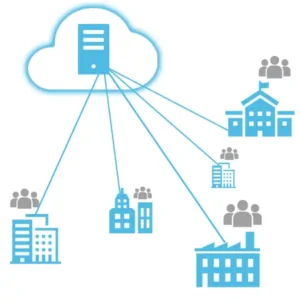Was ist Multimandantenfähigkeit?
Vielleicht sind Sie schon einmal auf den Begriff "Mehrmandantenfähigkeit" im Zusammenhang mit der Informationstechnologie. Was genau bedeutet es und was macht es?
Einfach ausgedrückt, ist "Multi-Tenancy" ein Begriff, der eine Architektur beschreibt, in der eine einzige Softwareinstallation oder ein einziger Dienst verwendet wird, um Dienste für mehrere, autonome Organisationen bereitzustellen. Jede Organisation wird als "Mieter" bezeichnet.
Wenn man sich vorstellt, was einem normalerweise in den Sinn kommt, wenn man das Wort "Mieter" hört, nämlich jemand, der eine Wohnung in einem Gebäude mietet, ist der Vergleich nicht unähnlich.
Betrachten wir den Vergleich einen Moment lang. Stellen Sie sich ein Mehrfamilienhaus und die darin lebenden Mieter vor. Sie haben ein großes Gebäude, das in Wohnungen unterteilt ist. Es gibt Gemeinschaftsbereiche wie die Eingangstür, die Flure und vielleicht die Waschküche. Strom, Gas und Wasser werden an das Gebäude als Ganzes geliefert und dann an die einzelnen Wohnungen weiterverteilt.
Abgesehen von den Gemeinschaftsräumen hat jeder Mieter seinen eigenen privaten Wohnbereich. Sofern Sie Ihren Nachbarn nicht einladen, können die Mieter die Wohnräume der anderen nicht betreten. Gleichzeitig nutzen sie aber alle die vom Vermieter bereitgestellten gemeinsamen Ressourcen, z. B. die Versorgungseinrichtungen und andere Dienstleistungen. Anstatt eine eigene Wohnung zu kaufen, zahlen die Mieter für die Nutzung von Teilen der gemeinsamen Ressourcen in Form einer Wohnung und aller anderen damit verbundenen Dienstleistungen.
Was bedeutet das nun für die Informationstechnologie?

Bereitstellung virtualisierter Anwendungs- und Desktop-Dienste
OVD Enterprise 2.7 führt die Unterstützung für mandantenfähige Installationen ein.
Wie in dem Vergleich mit dem Wohnhaus kann eine einzige Instanz von OVD Enterprise verwendet werden, um virtualisierte Anwendungen und Desktops für mehrere Mieter bereitzustellen. OVD ist das Äquivalent zum Mehrfamilienhaus in unserem vorherigen Beispiel. Neben der OVD-Serverfarm können auch andere Ressourcen wie Dateiserver und Verzeichnisdienste zusammengeführt und gemeinsam genutzt werden.
Sicherheitserwägungen bei Mehrmandantenfähigkeit
Sicherheit ist ein wichtiger Aspekt in einer mandantenfähigen Umgebung.
Ihre Unternehmensdaten sind heute Ihr wertvollstes Gut. Je nach Art des Unternehmens oder der Branche, in der Sie tätig sind, müssen Sie unter Umständen strenge gesetzliche Vorschriften zum Datenschutz einhalten. Das Gesundheitswesen und die Finanzdienstleistungen sind zwei Beispiele für stark regulierte Branchen.
Mit OVD werden die Mieter voneinander isoliert (oder siloartig), um ihre Daten zu schützen. Wie in unserem Beispiel mit dem Mehrfamilienhaus können OVD-Mieter gemeinsame Ressourcen nutzen (z. B. Speicherserver, Sicherheitsgateways, Web-Zugangsserver usw.), aber letztendlich bleiben ihre Daten in ihrer eigenen abgeschlossenen Wohnung geschützt. Jeder Mandant innerhalb von OVD hat im Wesentlichen seine eigene abgeschottete Instanz von OVD, komplett mit einem eigenen Administrator. Kein Mieter kann auf die Daten eines anderen Mieters zugreifen, es sei denn, er ist speziell dafür konfiguriert.
OVD ermöglicht eine zusätzliche granulare Benutzerrichtlinienkontrolle, die die Benutzeraktivitäten auf der Mandantenebene selbst weiter einschränkt. Administratoren schränken ein, wer auf Daten zugreifen kann und was sie damit tun dürfen (z. B. Kopieren/Einfügen, Drucken, Anschließen von USB-Geräten oder Herunterladen auf ihr lokales Gerät).
Vorteile von Multi-Tenancy
Der Hauptvorteil von Multi-Tenancy ist die Möglichkeit, Ressourcen zu konsolidieren und die Nutzung von IT-Investitionen zu maximieren. Anstatt dedizierte Systeme zu implementieren und zu verwalten, können die Ressourcen des Rechenzentrums nun gebündelt und über mehrere AD-Domänen hinweg gemeinsam genutzt werden (zusammen mit den entsprechenden Kosten).
Weitere Vorteile sind:
- Verbesserte IT-Effizienz durch Reduzierung von Doppelarbeit
- Langfristig niedrigere Kosten
- Rationalisierte Verwaltung durch Konzentration auf eine gemeinsame Umgebung, nicht auf mehrere unterschiedliche Systeme
- Schnellere Einführung neuer Dienste für Kunden
Anwendungsfälle
OVD Unternehmen ermöglicht es jeder Organisation, virtualisierte Windows- und Linux-Anwendungen und -Desktops für verschiedene Plattformen bereitzustellen. OVD unterstützt die Bereitstellung für Windows, macOS, Linux, iOS, Android, Chrome, Thin-Clients und clientlose, browserbasierte HTML5-Geräte. Sie kann als Vor-Ort-Lösung installiert oder als Service über eines der Inuvika-Angebote bereitgestellt werden. globales Netzwerk der Partner von Managed Service Providern (MSPs).
Anbieter von verwalteten Dienstleistungen
Als mandantenfähige Lösung ist OVD Enterprise bestens geeignet, um MSPs bei der Maximierung ihrer Rechenzentrumsressourcen zu unterstützen und neue Serviceeinnahmen zu erzielen. Sie können eine Instanz von OVD Enterprise zusammen mit anderen gemeinsam genutzten Rechenzentrumsdiensten nutzen, um maßgeschneiderte Anwendungen und Desktops als Service für mehrere Organisationen bereitzustellen. Und das alles, ohne für jede Organisation eine eigene Umgebung verwalten zu müssen.
Multi-Branchen-Organisationen
OVD eignet sich auch gut für Unternehmen mit mehreren Niederlassungen, Abteilungen oder verschiedenen Geschäftsbereichen. Diese Organisationen möchten möglicherweise von einem zentralen IT-Zentrum aus Dienste für mehrere autonome Abteilungen bereitstellen, diese aber dennoch voneinander isolieren und als Ganzes verwalten.
Zum Beispiel:
- Handelsunternehmen mit unabhängigen Tochtergesellschaften oder Unterabteilungen.
- Regionale Schulträger oder Hi-Ed-Einrichtungen mit mehreren Standorten
- Regierung und andere öffentliche Einrichtungen mit eigenen Abteilungen oder Bereichen
- Organisationen mit besonderen Sicherheitsanforderungen, die eine Isolierung von Teams oder bestimmten Benutzergruppen erfordern
Möchten Sie mehr erfahren?
Um mit einem Inuvika-Vertreter zu sprechen, oder um Kostenlose Testversion anfordern von OVD Enterprise, Kontakt uns.
Zusätzliche Ressourcen
Inuvika veröffentlicht neue OVD Enterprise 2.7.0 mit Multi-Tenancy
Erfahren Sie mehr über die OVD-Funktionen
Was ist neu in OVD 2.7?
Multi-Tenant-Leitfaden für OVD
